 |
Visible Analyst Corporate |
The Visible Analyst Corporate edition, Visible's flagship modeling product, continues to provide capabilities that make it the industry leader in the database design and data modeling market. In addition to automating all of the traditional structured methods, the Corporate edition also features advanced database engineering, transition to object oriented design, repository extensibility, distributed repository capabilities, and model permission controls. This new edition is suitable for large projects with multiple groups of users. The Corporate edition is suitable for Computer Analysts, Programmer Analysts, Project Leaders and Managers, and Designers.
Key Features of Visible Analyst Corporate
- Multi-user concurrent access enables team collaboration.
- Business Process Modeling Notation using the BPMN notation developed by the Business Process Management Initiative (www.bpmi.org) and the Object Management Group (OMG www.omg.org) is specifically suited for modeling the business processes. These diagram models communicate the business processes including the events (triggers) that begin, end or interrupt the processes, and the information (artifacts) used and developed by the processes. The BPMN notation supports Private (internal), Abstract (public) and Collaboration (global processes).
- IntelliViews™ - Visible's exclusive technology develops view specifications as you are data modeling - tracking name changes to every location and formula in which they are used, eliminating errors.
- XML Schema Generation has been added allowing the users to generate XML Schema based on the W3C standard for the entities and (optionally) classes developed in their project. Simply use the classes on an entity relationship diagram and the classes will be included in the XML Schema generation.
- ERwin file import / export capabilities. The import has been updated to include v7.x ERWin XML model import.
- Smart Reverse Engineering - Reverse engineering analyzes legacy databases to find relationships not expressly defined to the database. Allows the tool to "infer" relationships where none is defined.
- Database Compare Now you can compare your data model against a database schema and visually inspect the differences.
- Links to Source Code Under Version Control Because the software development process does not end when your models have been completed, it is important to be able to link your models elements to the source code that actually implements them. Now you can link any model element to a file under source code control by a Microsoft SCC-compliant provider, such as Razor.
- Enhanced Reporting Options The Visible Analyst repository has been extended to allow users to create custom reports through the use of third party tools such as Crystal Reports or any SQL Query application. Any Visible Analyst project hosted on an ODBC compliant database such as Oracle, MS SQL Server, etc. can access these additional tables and views to report on the repository and diagram data.
- Transition from Relational to Object Oriented methods.
- Supports on-the-fly denormalization of data models for better performing physical database designs (while preserving your logical business data model).
- Object Browser - Allows easy navigation and manipulation of all entities, attributes and relationships in the repository.
- Forward and reverse engineering through ODBC, direct connection or SQL DDL for virtually all databases.
- Generates AS/400 DDS.
- Methodology and rules checking support for SSADM, Metrica, Gane/Sarson, and Yourdon/Demarco.
- Web publish models (reports and diagrams) for sharing across the Internet with standard HTML and JPEG formats.
- Includes interfaces to Visible Developer allowing users to generate 90+% of the business and database access logic for typical business applications. Import data models from existing databases or Visible Analyst into Visible Developer , then define your business objects using powerful and intuitive modeling features.
Strategic Planning
Planning and requirements identification is often the initial phase in an enterprise engineering project. During the planning phase, you develop a comprehensive strategic business plan that meets the identified mission and purpose of the organization. Visible Analyst not only allows you to create these statements, but also to link them to other meta-data objects in your repository. This allows you to track the software development process from the planning stages, through analysis, design, and implementation. Linking planning statement to model objects helps you determine the significance of each object and ensures that each object is essential in supporting the organization's business plan.
Buusiness Process Modeling Notation (BPMN)
he Business Process Model diagram, using the BPMN notation developed by the Business Process Management Initiative (www.bpmi.org) and the Object Management Group (OMG www.omg.org) is specifically suited for modeling the business processes. These diagram models communicate the business processes including the events (triggers) that begin, end or interrupt the processes, and the information (artifacts) used and developed by the processes. The BPMN notation supports Private (internal), Abstract (public) and Collaboration (global processes).
Data Modeling and Database Design
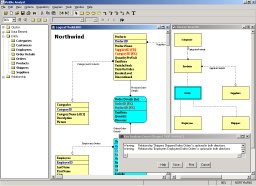 Visible Analyst Corporate edition supports entity-relationship diagrams (ERDs) based on data modeling notations defined by IDEF1X, Bachman, and Information Engineering (IE). ERDs can be automatically generated from the data dictionary and Repository information and generate multiple views based on Subject Area, Functional area, or any user selected set of Entities and associations. Visible Analyst automatically synchronizes cascaded foreign keys, and dynamically maintains syntactically correct ERDs. In addition, Visible Analyst Corporate edition interactively checks and resolves normalization problems and provides key analysis. Multiple display options include entity, entity/key, entity/attribute, and entity/attribute-physical. Detailed Entity and Business Rules Reports can be generated. Visible Analyst Corporate edition supports entity-relationship diagrams (ERDs) based on data modeling notations defined by IDEF1X, Bachman, and Information Engineering (IE). ERDs can be automatically generated from the data dictionary and Repository information and generate multiple views based on Subject Area, Functional area, or any user selected set of Entities and associations. Visible Analyst automatically synchronizes cascaded foreign keys, and dynamically maintains syntactically correct ERDs. In addition, Visible Analyst Corporate edition interactively checks and resolves normalization problems and provides key analysis. Multiple display options include entity, entity/key, entity/attribute, and entity/attribute-physical. Detailed Entity and Business Rules Reports can be generated.
Class Modeling with Relational / Object Transition
Visible Analyst Corporate edition provides class definition including attributes, methods (with parameter lists), type of visibility, and relationships. Visible Analyst verifies aggregation and inheritance relationships and pure virtual methods in abstract classes. UML (Unified Modeling Language) and Rumbaugh OMT notations for class diagrams are supported. Any relational Entity can be transitioned to become an OO Class (and vice versa), or either can be left as pure relational or pure object.
IntelliViews™ - Database View Support
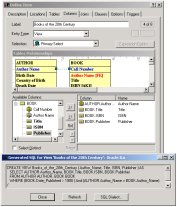 Visible Analyst Corporate features Visible's exclusive IntelliViews technology. All data modeling tools on the market today allow you to model entitities and generate SQL to create tables in a database schema. A few tools allow you to model database views. When it comes to actually specifying the Select clause used for filtering, most require you to manually type in the SQL used to define the filtering criteria for a specific SQL dialect. But Visible's IntelliViews technology is more sophisticated. Visible Analyst Corporate features Visible's exclusive IntelliViews technology. All data modeling tools on the market today allow you to model entitities and generate SQL to create tables in a database schema. A few tools allow you to model database views. When it comes to actually specifying the Select clause used for filtering, most require you to manually type in the SQL used to define the filtering criteria for a specific SQL dialect. But Visible's IntelliViews technology is more sophisticated.
- If a name is changedanywhere in the tool, any filtering clauses, calculation formulas and expressions will be updated properly.
- When generating the database schema, the SQL is translated to dialect-specific syntax, ensuring error free SQL.
- Code does not need to be specified for joins based on foreign key relatiuonships defined in the model. It is automatic at generation time.
- If necessary, secondary Views will be dynamically created to implement the join specified, allowing Visible Analyst to (for instance) fool databases that do not support outer joins to support them anyway.
- The SQL generator will seamlessly bridge any differences between the logical data model and its (denormalized) physical implementation.
Process Modeling
Visible Analyst Corporate edition supports the techniques and notations for Yourdon/DeMarco, Gane & Sarson, SSADM and Metrica methodologies. Processes and data stores are automatically numbered (Gane & Sarson) on data flow diagrams (DFDs). Visible Analyst enables "top-down" and "bottom-up" analysis and design approaches. Balancing, leveling, syntax, and completeness are interactively checked and resolved and data flows are automatically balanced. In addition, Visible Analyst automatically populates the integrated Repository and supports splitting of data flows from Repository definitions. Process decomposition diagrams are automatically generated from the DFD structure.
The following process modeling and design techniques are supported:
- Data Flow Diagrams (DFDs) business process & systems analysis modeling with automatically derived decompositions
- Functional Decomposition Diagramming (FDDs)
- Structure Chart Application Design Modeling
- Entity Life History (ELH) Diagrams including SSADM & Metrica methodologies
Business Modeling
Visible Analyst Corporate edition supports the modeling business functions and system processes and is fully integrated to support FDDs through an integrated repository (including auto-generation of DFDs from FDDs with automatic process balancing). The functional decomposition techniques of IE (Martin) methodology is completely supported. Automatic connection of functions and processes to subsidiary functions and processes are supported. Intelligent page connectors are available for large models. Validation of completeness and consistency of functions and processes are supported.
Structured Design Modeling
Visible Analyst Corporate edition supports Structure Design Modeling for Yourdon/Constantine and Page-Jones methods and automatically populates an integrated Repository. This model integrates with data flow models and includes syntax and completeness checking. Modules, Macros, and Library Modules are supported; and the Corporate edition allows for control of both couples and data couples. Multiple invocation techniques can be specified including direct, in-line, decision, and pathological. Design complexity and structure of charts can be measured. Information clusters, interface tables, and intelligent page connectors for large diagrams are also supported.
State (Transition) Modeling
Visible Analyst Corporate edition provides dynamic modeling using Unified Modeling Language (UML) and Rumbaugh/OMT notations. Syntax is automatically checked via an integrated rules engine. State transition diagrams (STDs) are linked to class definitions which show the attributive values and methods affecting them. The Visible analyst repository is automatically populated with state and event objects integrated with class methods.
Visible Analyst Corporate edition supports Metrica and SSADM methodologies using entity life history diagrams (ELHs) for modeling events in a system. The ELH diagram shows how events in a system affect data entities. An ELH applies to a single entity that originates on a logical data structure diagram. There can be an ELH diagram for each entity on a logical diagram. An ELH diagram is derived from the Jackson structure diagram and represents the processing performed on the data depicted by an entity.
Enterprise Modeling and Repository Management
Visible Analyst Corporate edition supports enterprise modeling by linking together projects in a parent-child relationship, enabling a distributed meta-data repository implementation. The Enterprise project is used to warehouse all information pertaining to an organization, while the satellite project contains only a subset of the enterprise project allowing users to work with components that are important to their development rather than details of the entire enterprise. Individual software development projects can be merged into a single strategic meta-data repository that provides concurrent access of the meta-data objects by multiple developers. Models may be shared throughout an organization and can be synchronized dynamically with satellite projects.
Database Schema Generation & Forward / Reverse Engineering of Existing DatabasesVisible Analyst Corporate edition can generate databases schemas directly from your ERDs via ODBC or SQL DDL scripts. The Corporate edition helps you develop quality client/server applications, with support for domains (user defined data types), stored procedures, triggers (with referential integrity trigger generation), indexes, primary keys, and foreign key referential integrity constraints on applicable databases.
Visible Analyst Corporate edition enables schema generation and reverse engineering of a wide range of popular desktop and client/server databases. You can connect directly to the target database via drivers that conform to Microsoft's Open Database Connectivity (ODBC) standard, native drivers for many popular databases, or generate SQL DDL via a text file and have the database process it.Visible Analyst Corporate edition gives you the ability to read and understand the structure of the existing database system, which saves time and increases accuracy. Once the database has been reverse-engineered, you can automatically generate ERDs to reflect its structure. Then you can update the created model and regenerate it using the same or different database type. When you reverse engineer, you capture structures of tables, indexes, primary keys, foreign keys, stored procedures, triggers, and physical storage parameters.
Repository, Networking, and Reporting Features
The Visible Analyst Corporate Repository functions interactively with the diagramming and rules to automatically create an organized database of project information for each project as it is developed. The Repository is automatically updated and maintained during all of your work sessions and it can be accessed at any time to manually add, delete, edit or review entries. The multi-user functionality permits concurrent access, simultaneous update, and row level locking.
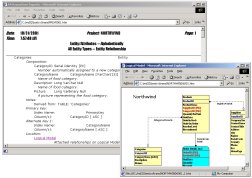 Visible Analyst Corporate edition supports a variety of comprehensive repository reports based on the current project repository and other project information. Custom Repository reporting capabilities are also supported. The Corporate edition supports report preview (using your Internet browser), print to file, or printer. Web publishing of repor ts and diagrams for sharing across the Internet in standard HTML and JPEG formats are also supported. Detailed Entity and Business Rules Reports can be generated based on the model details entered into the repository. Visible Analyst Corporate edition supports a variety of comprehensive repository reports based on the current project repository and other project information. Custom Repository reporting capabilities are also supported. The Corporate edition supports report preview (using your Internet browser), print to file, or printer. Web publishing of repor ts and diagrams for sharing across the Internet in standard HTML and JPEG formats are also supported. Detailed Entity and Business Rules Reports can be generated based on the model details entered into the repository.
Database Types Supported
- Access
- ANSI SQL-92
- Centura SQLBase
- DB2 2.x, 5.x, 6.x, 7.x, 8.x
- DBASE IV SQL
- Datacom SQL
- Informix SQL
- Ingres SQL
- InterBase SQL
- Netware SQL
- Oracle 7.x, 8.x, 9.x, 10.x
- Paradox
- Progress 7.x, 8.x Native 7.x, Native 8.x
- Rdb SQL
- SQL Server 4.x, 6.x, 7.x, 2000, 2000 Ent., 2005 Ent.
- SYBASE SQL Server System 10/11
- Teradata SQL V2 R2
- Unify SQL
- Watcom / SQL Anywhere
- XDB SQL
- Popular desktop DBs via ODBC... and customizable dialects
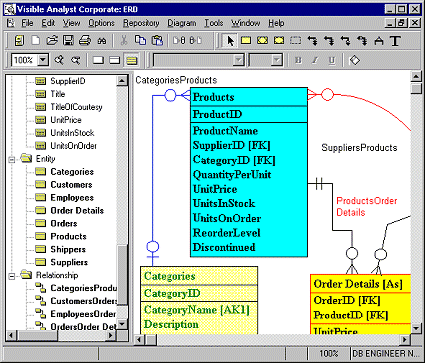
Visible Analyst has a convenient Object Browser (left) from which you can drag and drop Entities and Relationships onto your ERD. There are extensive diagram color and line options to alter the look of your diagrams.
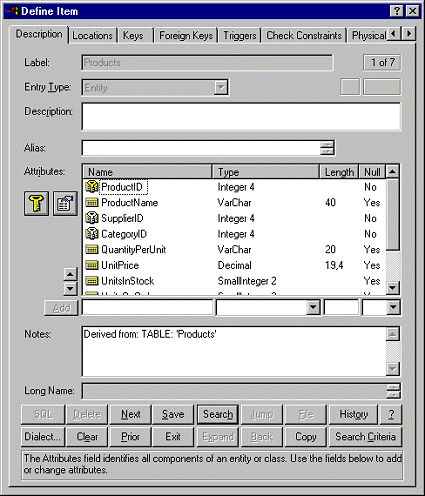
The Entity editor provides easy access to all of the common characteristics needed by the Database Analyst. |







